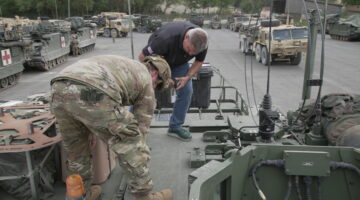
WASHINGTON: The close encounter between a Russian warship and an American destroyer in the Arabian Sea last week was more than a new round of the Russian military playing high-stakes cat-and-mouse. It was a forceful reminder that Russia hopes to gain influence in the region as the US sends thousands of new troops, aircraft, and ships to a region President Trump has long claimed he’s anxious to leave.
As the Trump administration publicly wrangles with the Iraqi government over US troops there and repositions some 18,000 troops it has rushed to the region over the past several months, the Russians and the Chinese are maneuvering for advantage.
“There’s no question the Middle East is at the epicenter of great power competition,” said Seth Jones, director of the Transnational Threats Project at the Center for Strategic and International Studies. “The Russians see the US interest in withdrawing forces as an opportunity to expand their power and interests.”
Last week, one day after Iraq’s parliament demanded the departure of US troops from their soil in a non-binding vote, China’s ambassador to Iraq paid a visit to Prime Minister Adil Abdul al-Mahdi with an offer to “rebuild and support the Iraqi government and people,” while noting Beijing’s desire to “increase security and military cooperation” with Baghdad.
In the meantime, Russia and Iraq have been talking on and off for over a year about a deal for the Russian-made S-400 or S-300 air defense systems. Those talks appear to have been given a new sense of urgency after the US Hellfire strike that killed Iranian Gen. Qassem Soleimani earlier this month, and Iran launching 15 ballistic missiles at Iraqi military bases in response.
An Iraqi government official recently told Russia’s RIA Novosti news agency that talks with Moscow are ongoing, even after previous discussions were scuttled when the US threatened sanctions if Baghdad purchased more Russian military technology.
This probing for advantage in the quicksand of the Middle East is what Washington officials mean when they discuss Great Power Competition and point to the National Defense Strategy.
There are limits to what either country is likely to achieve at America’s cost. The Russian military’s ability to forward deploy troops and sustain them is extremely limited, and the Syrian deployment for the moment is about as deep as Moscow likely wants to get into having boots on the ground.
But there are other ways to exert influence. Putin has long courted Egyptian President Abdel Fattah al-Sisi, signing a $25 billion deal in 2015 to allow Russian state nuclear energy giant Rosatom to begin building Egypt’s first nuclear power plant. Moscow provides 85 percent of the financing. The two countries have also signed a slew of security and economic cooperation pacts in recent years, while Egypt withdrew from the Trump administration’s stab at building an “Arab NATO,” last April after losing faith in Washington’s commitment to the effort.
Just a month before that, Cairo and Moscow signed a $2 billion agreement for 20 Russian Su-35 warplanes, leading US officials to warn Egypt that it could be sanctioned under US law for buying Russian military equipment.
But American threats are falling on deaf ears, as the so-far toothless Countering America’s Adversaries Through Sanctions Act (CAATSA) has yet to be used to wean an ally off Russian gear. The Egyptians were likely heartened by the Trump administration’s refusal to slap sanctions on Turkey over their purchase of the S-400, a lack of action that the Iraqis and Saudis are no doubt studying closely.
In an ironic twist, the Western sanctions imposed on Moscow for its 2015 invasion of Ukraine ended up being a major boon for Putin to forger a closer relationship with Cairo. As part of the package, France cancelled the planned sale of two Mistral helicopter carrier ships to Russia, returning about $1 billion that Moscow had already paid for the ships. In quick order, Egypt stepped in to buy the ships — with money borrowed from Saudi Arabia — and added 50 KA-52 helicopters Moscow had already built for the ships, suddenly catapulting Egypt into a what could become a much more imposing naval power.
And in November, Russia delivered the first tranche what will be a delivery of 36 T-90 tanks to the Iraqi Army, a deal forged in the wake of American complaints in 2017 and 2018 that some US-supplied M1 Abrams tanks had fallen into the hands of Iranian-backed Iraqi militias fighting ISIS.
“The Russians have a deep, long-term role in the region; it is nothing like that for the Chinese,” Jones said. “The Chinese are not going to project a lot of military power in the region, but they are attempting to expand influence — for them it’s more economic than the hard power like the Russians have used.”
Beijing has quietly signed a series of economic cooperations deals with regimes in the region, as their outreach in Baghdad has shown. Most visibly, the Chinese government has used its advanced drone programs as a way to gain deeper military collaboration with deep-pocketed governments.
Saudi Arabia has built up an arsenal of Chinese-made ballistic missiles, and analysis suggests Beijing has helped the Saudi regime build its first facility to produce its own missiles. There have also been reports of the UAE flying Chinese Wing Loong II drones over Libya and Yemen, and the Saudis have bought both China’s CH-4 and the Wing Loong II drones, and has opened its own CH-4 production facility.
There is nothing to suggest that the Saudi reliance on US weaponry built up over decades is in serious danger, but it is also growing increasingly clear that governments in the Middle East are hedging their bets and taking advantage of a world where the United States — pursuing its America First policies — is far from the only ally who can sell stability. Or something close to it.

